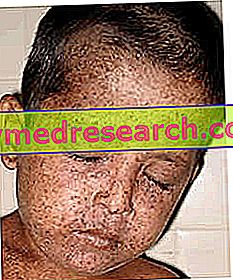Generality
Xeroderma pigmentosum is a rare hereditary genetic disease that causes abnormal and excessive sensitivity to sunlight.

The diagnosis of xeroderma pigmentoso is based on the observation of symptoms and signs, which are obvious and quite unequivocal.
Unfortunately, there is still no specific cure for healing, but treatment for symptom control is still available.
Chromosomes and repair of damaged DNA
Before describing the xeroderma pigmentosum, it is good to make a brief reference to genetics.
CHROMOSOMES AND DNA
Every cell of a healthy human being has 23 pairs of homologous chromosomes (23 are maternal and 23 are paternal). A pair of these chromosomes is sexual, that is, it determines the sex of the individual; the remaining 22 pairs, instead, are composed of autosomal chromosomes . In their entirety, the 46 human chromosomes contain the entire genetic material, better known as DNA . In the DNA of an individual are written his somatic traits, his predispositions, his physical abilities etc.
GENES AND MUTATIONS OF DNA

Figure: the organization of a gene within a pair of homologous chromosomes. A pair of homologous chromosomes contains specific genes, all having two variants, the alleles, occupying the same chromosomal position and doing the same functions (except mutations). The left pair of chromosomes has two equal alleles (both blue); the right pair instead has two different alleles (one is red, the other is blue).
DNA is organized within the chromosomes in many genes . Each single gene occupies a specific chromosomal position and presents two variants, called alleles, divided between a given maternal chromosome and its paternal homologue. Proteins come from genes. When a DNA mutation occurs, a gene of a given chromosome can be defective and consequently produce a defective protein.
CAN MUTATIONS BE REPAIRED?
Very often, genetic mutations (ie genes), which affect DNA, are repaired by repair systems . These are the result of the evolution of our organism, which, to survive and adapt to the environment, has devised various remedies, including this one.
The repair systems are different and, to work properly, they take advantage of the synchrony and the interaction of different repair proteins. Usually, they are very efficient, but it can happen that they make mistakes and do not solve a mutation.
If you understand where the proteins come from, you can also guess what happens after an incorrect mutation (therefore permanently) of a gene for a repair protein. The reparative system, in which the latter is involved, no longer works properly, its efficiency falls and DNA mutations increase due to the inability to repair them.
What is xeroderma pigmentoso
Xeroderma pigmentosum is a genetic disease that makes the skin extremely sensitive to ultraviolet ( UV ) radiation from sunlight. It is a congenital pathology (ie present from birth), which reduces quality and life expectancy.
The signs of xeroderma pigmentosus occur in areas of skin usually exposed to the sun and at eye level. In addition, various types of carcinoma develop in affected individuals and, in some cases, also neurological disorders.
Epidemiology
Xeroderma pigmentosum is a very rare disease. Its incidence, calculated for Europe and the United States, is one case in 1 million people. However, there are countries and regions of the world where it is slightly more frequent, such as in Japan, North Africa or the Middle East.
Xeroderma pigmentoso affects males and females, without particular distinctions, and manifests itself, with the first symptoms, already at an early age.
Causes
Xeroderma pigmentosum is caused by the mutation of a gene ( XP gene ) and its associated protein ( XP protein ); the latter, when normal, is responsible for repairing the damaged DNA. Therefore, due to the aforementioned mutation, the repair system with the XP protein as a protagonist does not work properly. It is self-evident that the individual affected by these disorders is more exposed to developing other DNA mutations, up until the appearance of skin carcinomas and eye tumors.
TYPES OF XERODERMA PIGMENTOSO
Actually, the gene that, together with its associated protein, causes xeroderma pigmentosum, is not always the same. In fact, at least 8 different XP genes have been identified, all on different chromosomes and all capable of producing, before mutating, proteins used to repair damaged DNA.
Despite being different genes and proteins, for simplicity we refer to them always with the general term XP and XP proteins. The only distinctive element is the addition of a letter of the alphabet, the first seven (from A to G) plus the V, based on the gene involved.
The following table shows the 8 different types of xeroderma pigmentosum; in it appear the conventional name, the chromosome affected by the mutation and the gene involved
| Types of xeroderma pigmentosum | ||
| First name | Mutated chromosome | Mutated gene and protein |
| Type Xeroderma pigmentosum (XPA) | Chromosome 9 | XPA |
| Type B Xeroderma pigmentosa (XPB) | Chromosome 2 | XPB |
| Xeroderma pigmentosa type C (XPC) | Chromosome 3 | XPC |
| Type Xeroderma pigmentoso (XPD); De Sanctis-Cacchione disease (XPD subtype) | Chromosome 19; Chromosome 10 | XPD ERCC6 |
| Type Xeroderma pigmentosa (XPE) | Chromosome 11 | DDB2 |
| Type Xeroderma pigmentos (XPF) | Chromosome 16 | ERCC4 |
| Type Xeroderma pigmentos (XPG) | Chromosome 13 | ERCC5 |
| Type V Xeroderma pigmentoso (XPV) | Chromosome 6 | POLH |
THE DNA REPAIR SYSTEM
All the proteins involved in xeroderma pigmentos usually devote themselves to DNA repair when it is damaged. Specifically, the repair system (known by the English acronym NER ), of which these proteins are part, is that which deals with the damage caused by the ultraviolet rays of the sun and by chemical mutagens (eg cigarette smoke).
In a healthy individual, the DNA of skin cells affected by the sun undergoes changes, which, however, are readily repaired by the NER. In contrast, in an individual with xeroderma pigmentosum, NER does not function properly and DNA damage caused by ultraviolet light or chemical mutagens remains. Think of this situation as a continuous accumulation of mutations, which, in the long run, predisposes to carcinomas and tumors of different types.
NB: the POLH gene of the XPV variant is not part of the NER system, but always deals with the repair of damage from the UV rays of the sun.
Deepening - UV damage and the NER repair system
Sunlight, when it affects our skin, causes small DNA mutations. In fact, UV rays form the so-called thymine dimers ( thymine is a fundamental component of DNA), which are nothing more than small structural anomalies of genetic material. These dimers, however, have a short life, because our body has developed, after millennia of evolution, repair systems that "erase" these genetic errors.
One of these repair systems is the so-called NER (from the English Nucleotide Excision Repair, or repair by nucleotide excision ). It is a perfect system, composed of several proteins, which recognizes the anomaly, cuts the mutated DNA region and replaces it with an identical portion.
It is a precise mechanism, which requires synchrony and the presence of all the proteins involved.
HOW IS THE XERODERMA PIGMENTOUS TRANSMITTED?

Figure: the autosomal recessive inheritance transmission. To have the disease, both parents must be carriers and, in the child, both alleles must be mutated.
Xeroderma pigmentosum is an inherited, autosomal recessive genetic disease .
- Hereditary, because the genetic mutation comes from the parents and is therefore congenital.
- Autosomal, because the chromosomes involved are autosomal and not sexual.
- Recessive, because the disease affects only those who have both alleles (of one of the above genes) mutated (homozygosity). The mutation of only one allele (for example, only the maternal one of chromosome 9) is not sufficient to cause the disease, but makes the affected individual a healthy carrier (heterozygosity). Likewise, even the heterozygosity of multiple XP genes is not sufficient.
CONTINUE: Xeroderma Pigmentoso - Symptoms, Diagnosis, Cure »



